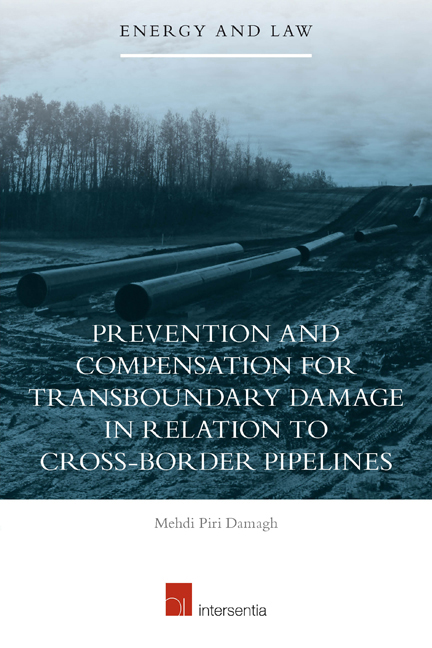Book contents
- Frontmatter
- Dedication
- Acknowledgements
- Contents
- Abbreviations
- List of Tables and Maps
- Chapter 1 Introduction
- PART I INTRODUCTORY ISSUES: PIPELINES, THE NATURE OF RISKS ASSOCIATED WITH PIPELINES AND THEIR REGULATORY REGIMES
- Introductory Note
- Chapter 2 General Features of Cross-border Oil and Gas Pipelines – The Ground Rules
- Chapter 3 Risks and Harm Relared to Cross-border Pipelines
- Chapter 4 Cross-border Pipelines: The International Legal Regime
- PART II PREVENTION OF CROSS-BORDER PIPELINE ACCIDENTS – MEANS AND SOURCES
- PART III STATE RESPONSIBILITY FOR TRANS-BOUNDARY DAMAGE CAUSED BY PIPELINES
- Summary
- Bibliography
- Valorisation Addendum
- Curriculum Vitae
Chapter 4 - Cross-border Pipelines: The International Legal Regime
from PART I - INTRODUCTORY ISSUES: PIPELINES, THE NATURE OF RISKS ASSOCIATED WITH PIPELINES AND THEIR REGULATORY REGIMES
Published online by Cambridge University Press: 13 December 2017
- Frontmatter
- Dedication
- Acknowledgements
- Contents
- Abbreviations
- List of Tables and Maps
- Chapter 1 Introduction
- PART I INTRODUCTORY ISSUES: PIPELINES, THE NATURE OF RISKS ASSOCIATED WITH PIPELINES AND THEIR REGULATORY REGIMES
- Introductory Note
- Chapter 2 General Features of Cross-border Oil and Gas Pipelines – The Ground Rules
- Chapter 3 Risks and Harm Relared to Cross-border Pipelines
- Chapter 4 Cross-border Pipelines: The International Legal Regime
- PART II PREVENTION OF CROSS-BORDER PIPELINE ACCIDENTS – MEANS AND SOURCES
- PART III STATE RESPONSIBILITY FOR TRANS-BOUNDARY DAMAGE CAUSED BY PIPELINES
- Summary
- Bibliography
- Valorisation Addendum
- Curriculum Vitae
Summary
INTRODUCTION
In the previous Chapter, it was shown that pipelines have the potential to cause trans-boundary damage. In fact, examples indicate that the construction and operation of pipelines sometimes lead to trans-boundary or transnational damage. It was further argued that these types of damage are, to a large extent, preventable. It was equally asserted that, by taking into account the particular features of such damage, compensation can face particular obstacles. It is therefore of importance in this research to discuss prevention as well as the liability issues. This research is aimed at evaluating the design of the safety and environmental regulations as well as liability rules in relation to such trans-boundary damage by focusing on the international obligations of states. It is the legal regime governing such cases, which determines which rules should be applied to either the prevention of, or compensation for the damage. For this purpose, it is necessary to explain the legal regime governing prevention and compensation of trans-boundary damage which might be caused by oil and gas pipelines. In this Chapter, therefore, the legal regime concerning cross-border pipelines, which covers safety and environmental regulations as well as liability rules, will be discussed. It should be noted that a detailed study of national laws and liability of operators is not the focus of this thesis.
It was noted that pipelines can be divided into cross-border and cross country pipelines. A cross-country pipeline is laid within the territory or under the control of one state. Hence, basically the national law of the source state should be applied for the prevention of trans-boundary damage. One, of course, should keep in mind that there are international and regional instruments which impose certain obligations on states for conducting appropriate preventive measures in relation to cross-country pipelines.
A cross-border pipeline is, on the one hand, subject to different regulatory regimes since it stretches beyond national borders. As indicated in Chapter 2, this research considers a pipeline as a cross-border pipeline when it traverses the border of at least two countries. Thus a cross-border pipeline is subject to different regulatory regimes since it stretches beyond national borders. In some cases, the pipeline only passes from an inlet country to an output country, whether terrestrial, such as the Iran-Turkey Gas Pipeline or subsea, such as the Russia-Turkey Gas Pipeline (Blue Stream). In other cases, a pipeline traverses producer, transit and consumer countries.
- Type
- Chapter
- Information
- Prevention and Compensation for Transboundary Damage in Relation to Cross-border Oil and Gas Pipelines , pp. 125 - 182Publisher: IntersentiaPrint publication year: 2015



